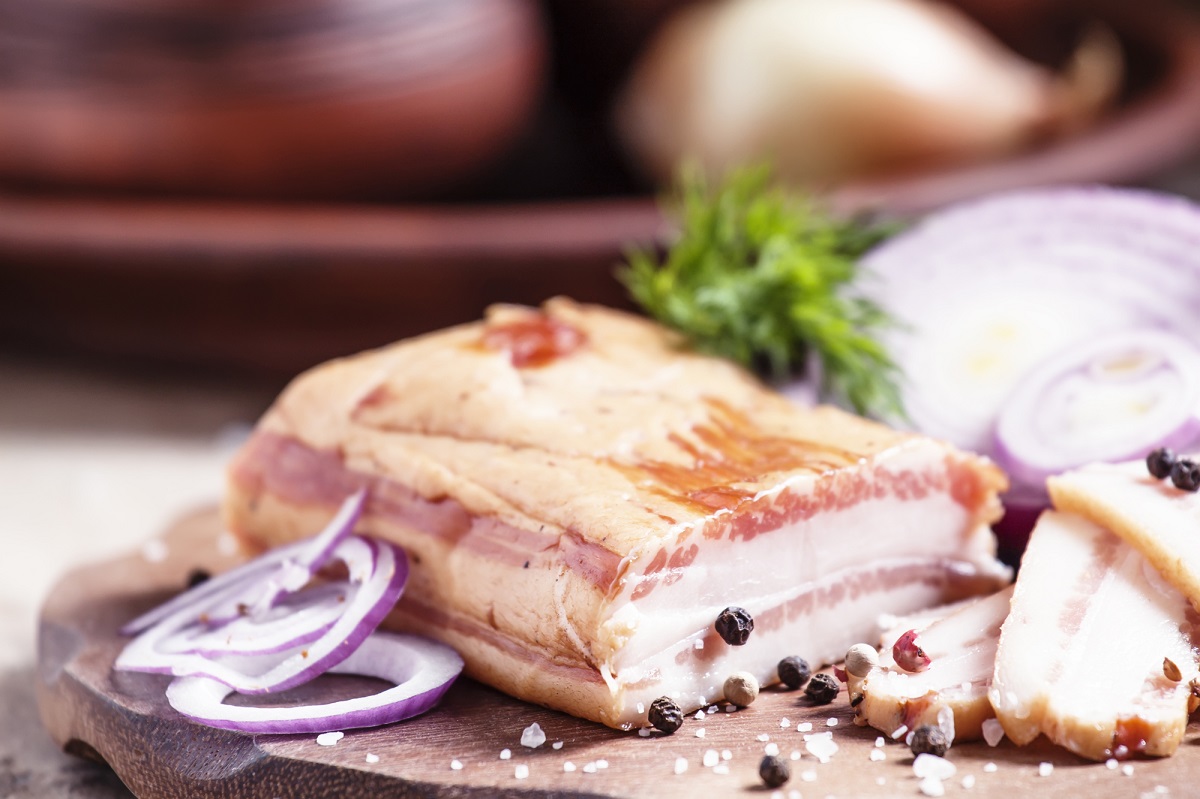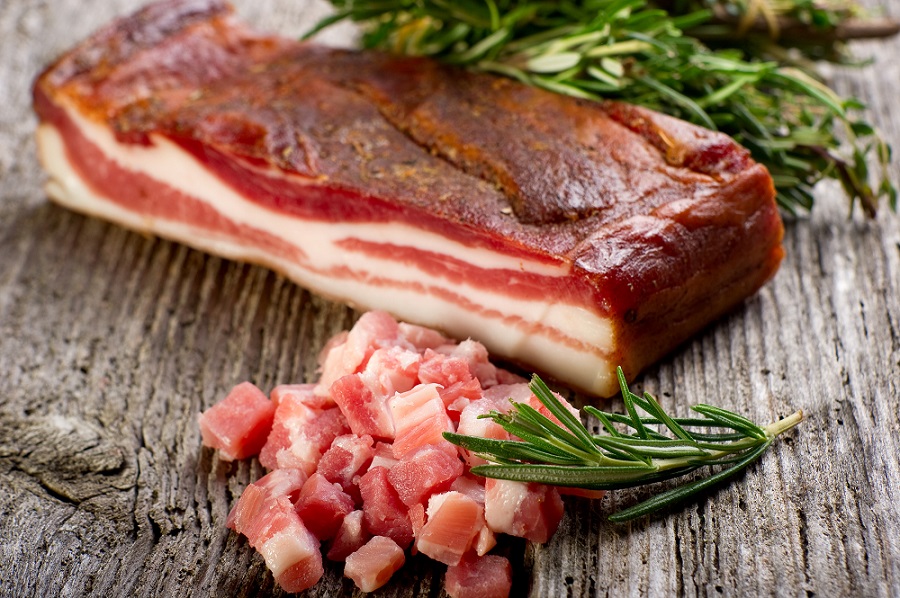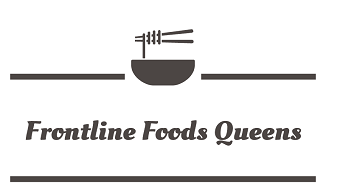Salt pork vs bacon, what makes them different from each other? Salt pork and bacon may seem similar, but there are distinct characteristics that set them apart. Salt pork is typically made from the belly of the pig and is saltier and fattier compared to bacon. Bacon, on the other hand, is made from the pork belly but it is also cured and smoked, giving it a distinct smoky flavor.
Both can be used in a variety of dishes, but understanding the differences between the two can help you make a more informed choice for your recipe. Experiment with both salt pork and bacon to expand your culinary skills.

What Is Salt Pork
The exact date of when salt pork became part of the culinary world is uncertain. Nevertheless, it was widely consumed by navy personnel and military in the 17th century because of its extended shelf life. It was a much-favored food for long voyages until the 19th century.
Nowadays, salt pork is often incorporated into soups and stews for the added saltiness and fat. It can be bought in grocery store and butcher shops and is used as a seasoning or curing agent. This type of pork meat is a key ingredient for many dishes, ranging from savory to sweet.
Salt pork and bacon are both pork products, but they have distinct differences. Salt pork is made from fatty pork cuts that are cured with salt and often smoked. This type of pork is most commonly used as a flavoring agent in soups, stews, and casseroles. Because of its saltiness and fat, it’s a great way to enhance the flavor of dishes.
It is also known for its long shelf life, lasting up to 4-5 months in the fridge or freezer. However, it is high in sodium, so it should be used in moderation if you are watching your salt intake. On the other hand, bacon is made from the belly of the pig and is typically cured and smoked. It is often used as a breakfast meat or as a topping for salads, sandwiches, and more.
Texture of Salt Pork
Salt pork is made from the belly or fatback and is cured in a brine solution for 2-3 days, resulting in a velvety texture and rich taste. Cold-cured pork belly can be seasoned with a flavorful rub or spice coating and is a popular home-curing project for a charcuterie board. It is widely enjoyed in regions from New England to the Cajun South, often served as a cured pork leg.

Types of Salt Pork
Salt pork comes in various forms, each with its own distinct flavor and texture, including:
Lardon
Lardon is thickly cut strips or cubes of salt pork, often used as a flavoring agent in soups, stews, or as a crust for roast meats. Its rich, salty flavor should be used with care.
Petit salé
Petit salé is a milder flavored salt pork that has been cured in brine and then smoked. It’s commonly used as a flavoring for sausages and pâtés and is a famous dish in France, often called Petit salé aux Lentilles, which is a combination of pork, lentils, and vegetables.
Jerky
Jerky is a dehydrated version of meat, often cut into strips, marinated with spices and salt, to create a flavorful taste. Jerky is made from lean meat, to ensure proper drying.
Salo
Salo is a form of salt pork that has been rendered down into pork fat, used as a cooking fat or spread for bread and pastries. It has a strong, savory flavor and should be used sparingly. It is a traditional Slavic food that is stored in cold and dark places.
What Is Bacon
Bacon is a popular cured meat made from pork belly cut. It is enjoyed worldwide and can be eaten on its own or used as a flavoring in various dishes. It is often used in parties and gatherings.
Bacon has a long history which can be traced back to China, where people first began curing meat with salt. Pork belly is typically the cut of meat most widely used for making bacon, and the curing phase usually lasts between 5-10 days.
Bacon can be cured in many ways, but the most common method is to soak it in a brine solution (water, salt, and sugar) for several days, followed by smoking or cooking to achieve the desired flavor and texture.
Bacon is a versatile ingredient that can be used in both sweet and savory dishes, such as toppings for salads, pizzas, and burgers, or as a wrapper for meats and vegetables. Consuming salt pork in moderation as part of a balanced diet is recommended due to its high fat and sodium content.
Types of Bacon
There are many types of bacon, each with its own unique flavor and texture. Some popular varieties include:
Middle bacon
Middle bacon is a popular cut in Australia, extracted where the back meat and the steak meet. It has a decent amount of fat and a texture resembling steak. It is often described as fatty and streaky slices of bacon and is delicious when cooked until crisp.
Side bacon
Side bacon is the most common type of bacon in the United States, made from the pork belly and typically has a fairly high-fat content. It is delicious when cooked crispy and makes a great addition to any dish.
Cottage bacon
Cottage bacon is extracted from the shoulder area of the pig and has a leaner meat texture. It’s cured and smoked like regular bacon and has a meatier texture than bacon made from pork belly.
Back bacon
Back bacon is popular in the United Kingdom and Ireland, made from pork loin, which gives it a leaner texture than side bacon. It is often cured and smoked, giving it a unique flavor that pairs well with eggs and toast.
Pancetta
Pancetta is an Italian type of bacon made from pork belly, typically cured and smoked, giving it a unique flavor that pairs well with pasta dishes.
Jowl bacon
Jowl bacon is made from pig cheeks, often considered a by-product after extracting all the good meat from the carcass, it can be fried and enjoyed as a main course.
Slab bacon
Slab bacon is a type of side bacon that’s popular in the United States, made from the pork belly and has a higher fat content than regular side bacon. It is delicious when cooked until crisp and makes a great addition to any dish.
Differences between Salt Pork and Bacon
Salt pork and bacon are both popular pork products, but they have some distinct differences.
Texture
In terms of texture, salt pork is softer and less dense than bacon. It has a spongy texture, while bacon is firm and chewy.
The Curing Process
The curing process also sets the two products apart. Salt pork is simply covered in salt or a brine solution and left to cure for 2 days, while bacon is injected or rubbed with a brine solution that includes nitrate. The meat is then hung to infuse smoke, giving it a smoky flavor.
Fat Contents
Fat content varies depending on the type of bacon, but salt pork is usually made from the fattiest part of the pork belly and therefore has a higher fat content.
Flavor
In terms of different flavors, salt pork has a milder, saltier and slightly sweet taste, while bacon has a more pronounced smoky flavor.
Cooking Process
Salt pork can be eaten raw, but it’s recommended to soak it in water to reduce saltiness. Bacon should always be cooked thoroughly to eliminate any potential food poisoning risks, with the exception of boiled and smoked bacon which can be eaten raw.
Shelf Life
Salt pork can be stored for up to 2 weeks at room temperature, but if kept in the freezer or refrigerator, it can last for 4 to 5 months. When it comes to bacon, the shelf life depends on several factors. An unopened package of bacon can last for a week in the refrigerator after the sell-by date.
To extend the shelf life for several months, storing bacon in the freezer is a good option. However, for optimal taste, it is best to use frozen bacon within 4 to 6 months. It’s important to be aware of the proper thawing methods for frozen bacon to avoid making it inedible.
If the package has been opened, bacon should be consumed within 7 days when stored in the refrigerator. Keep in mind that the flavor of bacon will start to degrade after 3 months in the freezer.
What Are the Similarities Between Salt Pork vs Bacon
Salt pork and bacon have some similarities despite their differences. Both are made from pork that has undergone a curing process using salt, which gives them their characteristic salty flavor. Furthermore, both salt pork and bacon can be utilized as a seasoning ingredient in various dishes.
Pro Tip: If you are having trouble getting bacon or salt pork, another option is to use beef jerky, cured vegetables, smoked ham, turkey bacon or flavored olive oil as substitutes.
Find Out if Your Salt Pork Has Gone Bad
Salt pork can be stored in the refrigerator for 4 to 5 months. To determine if it has gone bad, there are several ways to inspect it. First, check for any strong or unpleasant odors, such as those of rotten eggs, ammonia, or sulfur. If present, this indicates that the meat has been contaminated and should not be consumed.
Additionally, inspect the meat’s appearance. A normal piece of salt pork should be brown in color. Look for any discoloration, such as gray or light green, which can indicate the presence of mold or fungus on the meat.
Substitute Bacon For Salt Pork
Salt pork can be used as a substitute for bacon due to their similar curing process. However, seasoning salt pork with spices and smoking it with wood like hickory, applewood, or cherrywood will enhance its flavor and give it a smokiness similar to bacon.
On the other hand, unflavored, unsmoked bacon can be used to replace salt pork in dishes. In this case, it is important to note that bacon typically has less layer of fat than salt pork, so extra fat may need to be added to the dish.
Salt Pork vs Bacon – Which Is Better
The question of whether salt pork or bacon is better has been a topic of debate for many years. Both have their own unique qualities and flavor profiles. Salt pork is made from pork belly that has been cured with salt, while bacon is made from pork belly that has been cured with salt and smoke. This gives salt pork a stronger flavor compared to bacon, which has a more subtle flavor.
The choice between the two ultimately depends on personal preference and the dish being prepared. If a stronger pork flavor is desired, salt pork is the better option. If a more subtle flavor is preferred, bacon is the better option. Both meats can also be used interchangeably and both provide a meaty flavor overall.
Frequently Asked Questions About Salt Pork vs Bacon
Can I eat salt pork like bacon?
Salt pork can be eaten like bacon, but it is usually boiled first to reduce its salt content and partially cook it. Then it is fried until it becomes crispy. It can be eaten as is or used to add flavor to other dishes.
What is salt pork good for?
Salt pork is commonly used for rendering fat or as a flavoring ingredient in dishes like chowder and baked beans. It can also be used to add salt and fat to roasted or braised vegetables and can help add umami flavor to any dish.
Is salt pork cheaper than bacon?
Salt pork is a cheaper and more long-lasting meat option than bacon. It is a good option if you want to add meaty flavor to a dish without spending as much money. It can also be rendered down to cook and add flavor to vegetarian dishes.
Do you rinse off salt pork?
When using traditional salt pork, it is necessary to rinse off the salt before cooking.
Why does salted pork not spoil?
Salt is a effective preservative because it reduces the amount of water available for microbial growth and chemical reactions. This is why salted pork does not spoil.
Can you cook and eat salt pork?
Salt pork can be cooked by slowly rendering the fat from it. The fat can be used for cooking and the crisped up pieces of salt pork can be used as a garnish. To render salt pork, cut it into small cubes and add it to a skillet with a splash of water. Cook over low heat.
How long does salt pork take to cook?
Salt pork can be cooked by boiling it in water for 10 minutes, then draining and letting it cool.
How long will salt pork last?
Salt pork should be refrigerated when not in use. It can last up to two weeks unrefrigerated, but can last 4-5 months in the refrigerator and even longer when frozen.
Is salt pork the same as pancetta?
Pancetta is a salt and spice-cured pork belly that can be eaten without cooking. Salt pork is heavily salted to preserve it, has more fat and is used as a condiment to add to stews and other broths.
What does salt pork taste like?
Salt pork has a flavor similar to bacon. When fried, it loses moisture and the flavor becomes more intense.


